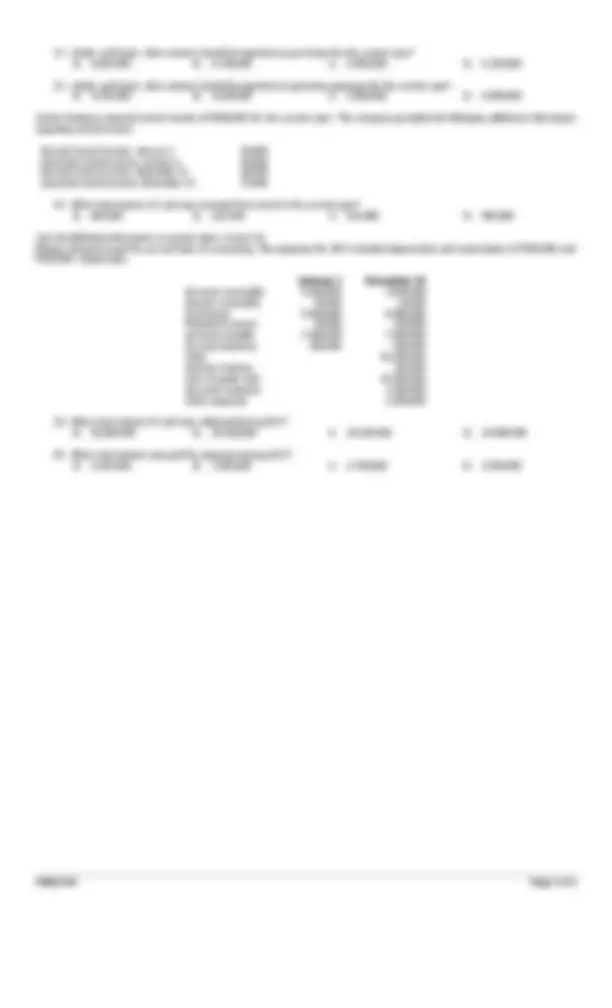
FARQ 204 Page 1 of 3
CASH AND ACCRUAL BASIS
I. FINANCIAL ACCOUNTING THEORIES
1. Under the accrual basis of accounting, cash receipts and disbursements may
A. Precede, coincide with, or follow the period in which revenue and expenses are recognized.
B. Precede or coincide with but never follow the period in which revenue and expenses are recognized.
C. Coincide with or follow but never precede the period in which revenue and expenses are recognized.
D. Only coincide with the period in which revenue and expenses are recognized.
2. Under IFRS
A. Events are recorded in the period in which the event occurs.
B. Net income will be lower under the cash basis than accrual basis accounting.
C. The cash basis method of accounting is accepted.
D. All of the foregoing are correct.
3. Which of the following does not describe a deferral under accrual accounting?
A. Cash collected in advance of services being rendered.
B. Cash paid upfront for a one-year insurance coverage.
C. Deferral typically results in the recognition of a liability or prepaid expense.
D. Deferral of revenue occurs when cash is received and recognized in profit or loss.
4. Which of the following statements is correct about accrual accounting and cash basis accounting?
A. Under the cash basis, if cash has been collected, revenue can be recorded even if the earnings process is not complete.
B. Under the accrual accounting, if the earning process is not complete, revenue is nevertheless recorded if the cash has
already been received.
C. Under the cash basis, revenue is recognized when the receivable is initially recorded.
D. All of the statements are correct.
5. Compared to cash basis net income for the current year, an entity’s accrual basis net income increased when it
A. Had higher accrued expenses at the end of the current year than at the beginning of year.
B. Had lower accrued expenses at the end of the current year than at the beginning of year.
C. Declared a cash dividend in the prior year that it paid in the current year.
D. Wrote off more accounts receivable than it reported as uncollectible accounts expense in the current year.
6. When converting from cash basis to accrual-basis accounting, which of the following adjustments should be made to cash
receipts from customers to determine accrual basis service revenue?
A.
Subtract ending accounts receivable. B.
Add ending accounts receivable.
C.
Subtract beginning unearned service revenue. D.
Add ending unearned service revenue.
7. When converting from cash basis to accrual basis accounting, which of the following adjustments should be made to cash paid
for operating expenses to determine accrual basis operating expenses?
A.
Add beginning accrued liabilities. B.
Subtract beginning prepaid expense.
C.
Subtract ending prepaid expense. D.
Subtract ending accrued liabilities
8. The closing balance of unearned fees represents
A. Cash received in advance and not yet earned during the period.
B. Cash paid in advance and not yet incurred during the period.
C. Fees earned but not yet collected during the period.
D. Expenses incurred but not yet paid during the period.
9. The closing balance of prepaid expenses represents
A. Cash received in advance and not yet earned during the period.
B. Cash paid in advance and not yet incurred during the period.
C. Fees earned but not yet collected during the period.
D. Expenses incurred but not yet paid during the period.
10. Compared to the accrual basis of accounting, the cash basis of accounting overstates income by the net increase during the
accounting period of the
Accounts receivable Accrued liabilities
A. Yes Yes
B. No No
C. Yes No
D. No Yes
II. FINANCIAL ACCOUNTING PROBLEMS
11. In November and December 2017, Flame Hot Magazine Company, a newly organized magazine publisher, received P75,000 for
1,000 three-year subscriptions at P25 per year, starting with the January 2018 issue. The company included the entire P75,000
in its 2017 income tax return. What amount should the company report in its 2017 income statement for subscriptions revenue?
A.
0 B.
4,167 C.
25,000 D.
75,000
12. Helium Corp.'s trademark was licensed to Hot Air Co. for royalties of 10% of sales of the trademarked items. Royalties are
payable semiannually on March 15 for sales in July through December of the prior year, and on September 15 for sales in
January through June of the same year. Helium received the following royalties from Hot Air:
March 15 September 15
2017 P5,000 P7,500











